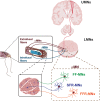Motor Neuron Diseases and Neuroprotective Peptides: A Closer Look to Neurons
- PMID: 34603008
- PMCID: PMC8484953
- DOI: 10.3389/fnagi.2021.723871
Motor Neuron Diseases and Neuroprotective Peptides: A Closer Look to Neurons
Abstract
Motor neurons (MNs) are specialized neurons responsible for muscle contraction that specifically degenerate in motor neuron diseases (MNDs), such as amyotrophic lateral sclerosis (ALS), spinal and bulbar muscular atrophy (SBMA), and spinal muscular atrophy (SMA). Distinct classes of MNs degenerate at different rates in disease, with a particular class named fast-fatigable MNs (FF-MNs) degenerating first. The etiology behind the selective vulnerability of FF-MNs is still largely under investigation. Among the different strategies to target MNs, the administration of protective neuropeptides is one of the potential therapeutic interventions. Pituitary adenylate cyclase-activating polypeptide (PACAP) is a neuropeptide with beneficial effects in many neurodegenerative diseases, including Alzheimer's disease, Parkinson's disease, and more recently SBMA. Another neuropeptide that has a neurotrophic effect on MNs is insulin-like growth factor 1 (IGF-1), also known as somatomedin C. These two peptides are implicated in the activation of neuroprotective pathways exploitable in the amelioration of pathological outcomes related to MNDs.
Keywords: ALS (Amyotrophic lateral sclerosis); IGF-1 (insulin-like growth factor 1); PACAP (pituitary adenylate cyclase-activating polypeptide); motor neuron (MN); motor neuron disease (MND); spinal muscular atrophy (SMA); spinobulbar muscular atrophy (SBMA).
Copyright © 2021 Zuccaro, Piol, Basso and Pennuto.
Conflict of interest statement
The authors declare that the research was conducted in the absence of any commercial or financial relationships that could be construed as a potential conflict of interest.
Figures


Similar articles
-
Dysregulation of Muscle-Specific MicroRNAs as Common Pathogenic Feature Associated with Muscle Atrophy in ALS, SMA and SBMA: Evidence from Animal Models and Human Patients.Int J Mol Sci. 2021 May 26;22(11):5673. doi: 10.3390/ijms22115673. Int J Mol Sci. 2021. PMID: 34073630 Free PMC article.
-
Autophagy in motor neuron diseases.Prog Mol Biol Transl Sci. 2020;172:157-202. doi: 10.1016/bs.pmbts.2020.03.009. Epub 2020 Apr 24. Prog Mol Biol Transl Sci. 2020. PMID: 32620242 Review.
-
Genetic architecture of motor neuron diseases.J Neurol Sci. 2022 Mar 15;434:120099. doi: 10.1016/j.jns.2021.120099. Epub 2021 Dec 22. J Neurol Sci. 2022. PMID: 34965490 Review.
-
Altered ionic currents and amelioration by IGF-1 and PACAP in motoneuron-derived cells modelling SBMA.Biophys Chem. 2017 Oct;229:68-76. doi: 10.1016/j.bpc.2017.05.003. Epub 2017 May 10. Biophys Chem. 2017. PMID: 28511915
-
Differential Vulnerability of Oculomotor Versus Hypoglossal Nucleus During ALS: Involvement of PACAP.Front Neurosci. 2020 Aug 11;14:805. doi: 10.3389/fnins.2020.00805. eCollection 2020. Front Neurosci. 2020. PMID: 32848572 Free PMC article. Review.
Cited by
-
Agonist of growth hormone-releasing hormone improves the disease features of spinal muscular atrophy mice.Proc Natl Acad Sci U S A. 2023 Jan 10;120(2):e2216814120. doi: 10.1073/pnas.2216814120. Epub 2023 Jan 5. Proc Natl Acad Sci U S A. 2023. PMID: 36603028 Free PMC article.
-
Therapeutic Targets in Amyotrophic Lateral Sclerosis: Focus on Ion Channels and Skeletal Muscle.Cells. 2022 Jan 25;11(3):415. doi: 10.3390/cells11030415. Cells. 2022. PMID: 35159225 Free PMC article. Review.
-
Morphological segmentation with tiling light sheet microscopy to quantitatively analyze the three-dimensional structures of spinal motoneurons.Cell Regen. 2025 May 14;14(1):17. doi: 10.1186/s13619-025-00231-3. Cell Regen. 2025. PMID: 40360768 Free PMC article.
-
Unveiling the effect of curcumin on ion channels of SBMA motoneuron-derived cells and human IPSC-derived neurons: initial electrophysiological findings.Eur Biophys J. 2025 Jul 7. doi: 10.1007/s00249-025-01780-w. Online ahead of print. Eur Biophys J. 2025. PMID: 40624383
-
The Role of Sphingomyelin and Ceramide in Motor Neuron Diseases.J Pers Med. 2022 Aug 30;12(9):1418. doi: 10.3390/jpm12091418. J Pers Med. 2022. PMID: 36143200 Free PMC article. Review.
References
Publication types
LinkOut - more resources
Full Text Sources
Miscellaneous

